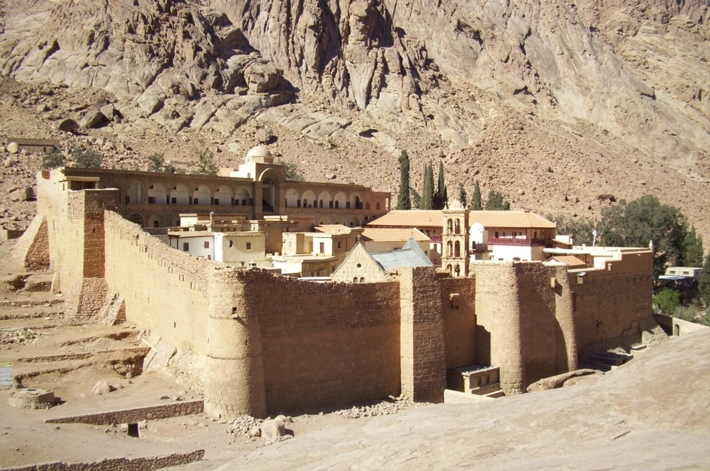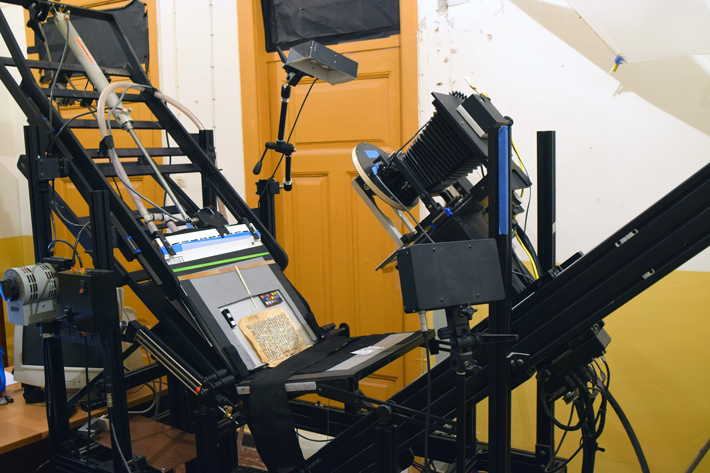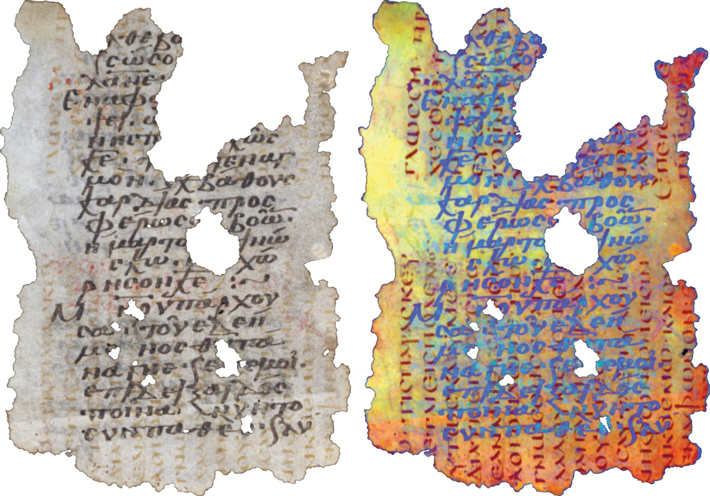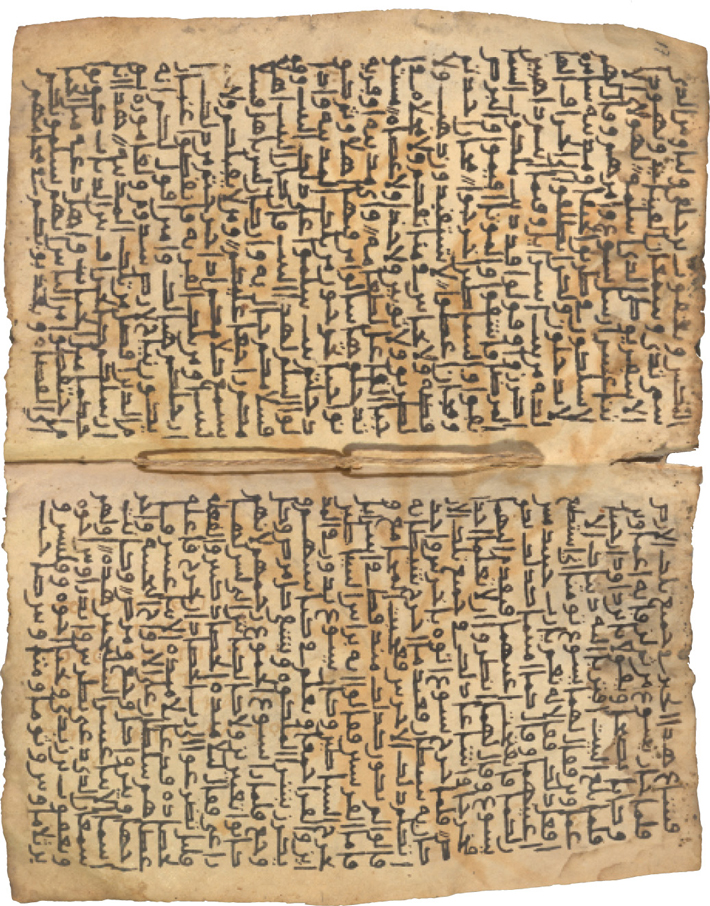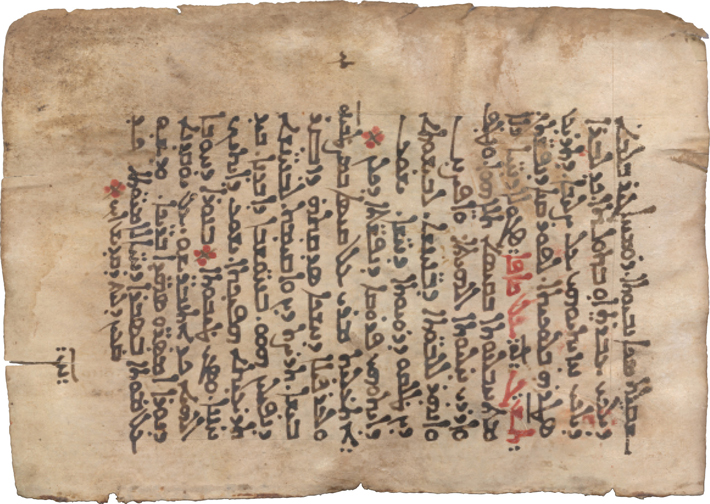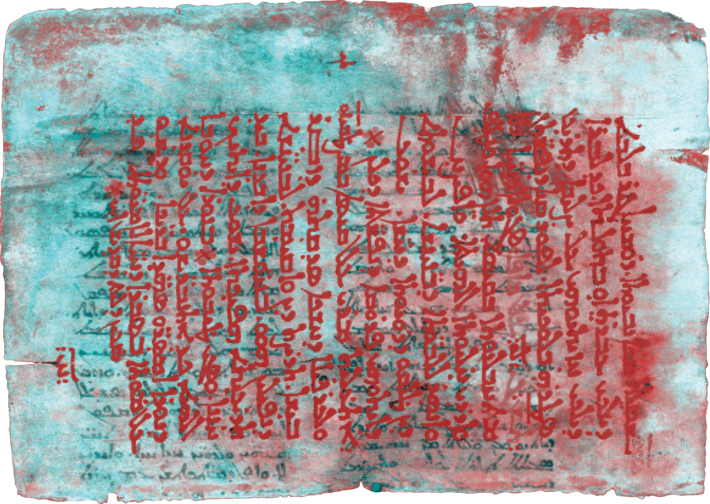DepthReading
Recovering Hidden Texts
St. Catherine’s Monastery was built at the foot of Mt. Sinai in the 6th century on the orders of the Byzantine emperor Justinian. Over time it became an important destination for Christian pilgrims. Monks have lived within its walls ever since, and still welcome travelers.
The Sinai Palimpsest Project’s spectral imaging system is equipped with a high-resolution camera and a custom cradle that holds manuscripts as they are subjected to four separate imaging techniques.
The Sinai Palimpsest Project’s spectral imaging system is equipped with a high-resolution camera and a custom cradle that holds manuscripts as they are subjected to four separate imaging techniques.
A fragment of a reused parchment, or palimpsest, covered with medieval Greek writing (left) shows faint traces of a text lying beneath. Multispectral imaging of the parchment (right) shows that the erased text, in red, is 1 Corinthians, transcribed in the 5th century.
A fragment of a reused parchment, or palimpsest, covered with medieval Greek writing (left) shows faint traces of a text lying beneath. Multispectral imaging of the parchment (right) shows that the erased text, in red, is 1 Corinthians, transcribed in the 5th century.
St. Catherine’s librarian Father Justin gingerly turns the page of a palimpsest undergoing multispectral imaging.
The monastery has a rich collection of icons and other religious objects, but it is most famous for its library, which, with more than 3,300 manuscripts, is second only to that of the Vatican in terms of the number of ancient texts it contains. While the Vatican library was assembled carefully over the centuries, St. Catherine’s collection is different, more eclectic. “The Sinai library differs from most libraries in that it grew organically to provide the monks with copies of the scriptures and books that would inspire and guide them in their dedication,” says Father Justin, who serves as the monastery’s librarian. Many of the monks and pilgrims who came to the monastery over the centuries left manuscripts as gifts, resulting in an especially idiosyncratic collection. In addition to important Christian texts, the library contains, for instance, one of the world’s earliest known copies of the Iliad.
Father Justin began a program of digitizing the monastery’s collection in the late 1990s. He knew, however, that he was unable to make a record of some of the most intriguing texts in the collection. Since the late nineteenth century, scholars had been aware that many of the works in the collection are palimpsests that conceal older texts (see “The Bible Hunters”). Over the years, scholars were able to read three of the palimpsests that were legible, but the vast majority remained invisible to the naked eye and went unstudied. In 1996, a Georgian scholar used ultraviolet light to read a Sinai palimpsest with an overtext in medieval Georgian. He found that the underlying text was written in Caucasian Albanian, and was the first example of a text written in this now-extinct language. It was an exciting discovery, but the process had drawbacks. “Prolonged use of ultraviolet light is a risk to both the eyesight of the scholar and the manuscript itself,” says Father Justin. The technique just wasn’t a practical way to read the library’s palimpsests.
Before multispectral imaging, writing on a medieval Arabic manuscript (top) concealed a full-page illustration of a medicinal herb (above) dating to the 5th century.
Before multispectral imaging, writing on a medieval Arabic manuscript (top) concealed a full-page illustration of a medicinal herb (above) dating to the 5th century.
Father Justin learned of an ambitious scientific and scholarly effort under way from 1998 to 2008 to use multispectral imaging technologies to read the Archimedes Palimpsest, a tenth-century copy of the great Greek philosopher’s writings that had been overwritten by thirteenth-century Christian monks. He contacted the team decoding the Archimedes Palimpsest, and soon many of the scientists involved in the project agreed to again pool their resources to read the Sinai palimpsests. Organization of the project fell to Phelps and the Early Manuscripts Electronic Library, which uses digital technology to make ancient manuscripts available online to both scholars and the general public.
In 2011, the Sinai Palimpsest Project began imaging some of the 130 manuscripts in St. Catherine’s library that had been identified as palimpsests. Over the course of five years, the team visited the monastery 17 times. Before each session, University of Vienna medievalist Claudia Rapp, the project’s scholarly director, would consult with Father Justin, and together they would select important palimpsests suitable for multispectral imaging. The team would then subject each page to four state-of-the-art technologies. One method developed specifically for the project involves backlighting each page with multiple wavelengths that reveal where the ink of the undertext had eroded the parchment.
These images, once processed and viewed in combination, render long-lost words legible. The Sinai Palimpsest Project has now imaged some 6,900 pages, collecting an unprecedented amount of data on these formerly illegible or invisible manuscripts. “I call this process the archaeology of the page,” says Rapp. “Except as we dig we don’t destroy the layers that lie above, and we’re still able to make things visible that have been hidden for centuries.”
The effort is already giving the team new insight into the role St. Catherine’s played in the medieval world. While it is one of the world’s most famous Christian sites, scholars have an incomplete picture of it during this period. “The history of St. Catherine’s from the seventh to the eleventh centuries is little known,” says Rapp. “The palimpsests dating to this period give us a new picture of the role the monastery played in the Christian world.” The diversity of languages found in the palimpsests, a total of 10, show that pilgrims came to St. Catherine’s from all over the Middle East and Europe. In addition to more text in Caucasian Albanian, the team has discovered palimpsests in Ethiopic, Slavonic, Armenian, and, importantly, in Latin, some written in a style that was popular in Anglo-Saxon monasteries. “We were surprised by the number of Latin texts,” says Rapp. St. Catherine’s is an Orthodox monastery and was previously not thought to have had strong links to the Latin-speaking Catholic Christian world. But the palimpsests show that a number of pilgrims from Western Europe, perhaps from as far away as Britain, made the trek to the monastery and left behind manuscripts that were then recycled.
For Rapp, another significant discovery the project has made is that a number of palimpsests were written in a dialect of Aramaic known as Christian Palestinian Aramaic. This language vanished in the thirteenth century, and is poorly understood, largely because so few texts are known, making the discovery of these palimpsests especially exciting for scholars. “We have increased the number of known Christian Palestinian Aramaic texts by 30 percent,” says Rapp. “I have a colleague preparing a grammar of the language, and she’s very grateful she didn’t publish it before we found these palimpsests.”
The content of the palimpsests also offers a look at the diversity of manuscripts that were available to monks in the early medieval period. Some of the palimpsests contain biblical texts such as fifth- and sixth-century versions of Corinthians and the book of Numbers, but they also hold a number of secular works that monks could have consulted. The team has identified a variety of medical writings, including a treatise on medicinal plants, which contains a treatment for scorpion stings, the earliest surviving texts of Hippocratic medical works, and a previously unknown version of a list of medical terms.
A medieval document (top) in Syriac, a dialect of Aramaic, was written on top of a 9th-century Syriac translation (above, in black) of an ancient Greek medical text.
A medieval document (top) in Syriac, a dialect of Aramaic, was written on top of a 9th-century Syriac translation (above, in black) of an ancient Greek medical text.
Those works hint at how the monks may have understood and treated illnesses, a very practical dimension of their lives, but the team has also found evidence that at least some monks could have relied on the library for pleasure reading. They have identified a palimpsest containing the illustrated version of a secular fictional work, the oldest known non-biblical illustrated manuscript, perhaps suggesting that monks may have not confined themselves to religious reading.
Soon one of the palimpsests may even allow the team an intimate glimpse of the monks’ spiritual lives. In it they have discovered musical notations, likely for a liturgical chant, which are still being studied. Once they are deciphered, the team may be able to recapture the sounds of one of the ancient chants that were such an integral part of religious services at the monastery.
Twenty-three scholars are currently at work translating the palimpsests, but enough have been studied that it is now clear that St. Catherine’s library is the world’s richest source of Christian palimpsests. And the project has helped Father Justin and the monks of St. Catherine’s not just to recover lost history, but also to celebrate their faith. “The manuscripts are an inspiration to the monks who live here today,” says Father Justin, who finds the discovery of the Latin texts, in particular, very significant. “They show that there was travel and communication between East and West, at a time when scholars have presumed great isolation. This is an important example for our own times.”
Thus far the team has imaged 75 of the manuscripts previously identified as palimpsests. In the process, Rapp has newly identified at least 30 more palimpsests in the collection. She believes that still more of the books in St. Catherine’s library may have been written on reused parchment. There could be hundreds more palimpsests yet to be discovered, an invisible library that may hold as-yet-unknown biblical texts, or more manuscripts that illuminate medieval monastic life in this remote outpost of Christianity.
Category: English
DepthReading
Key words:

